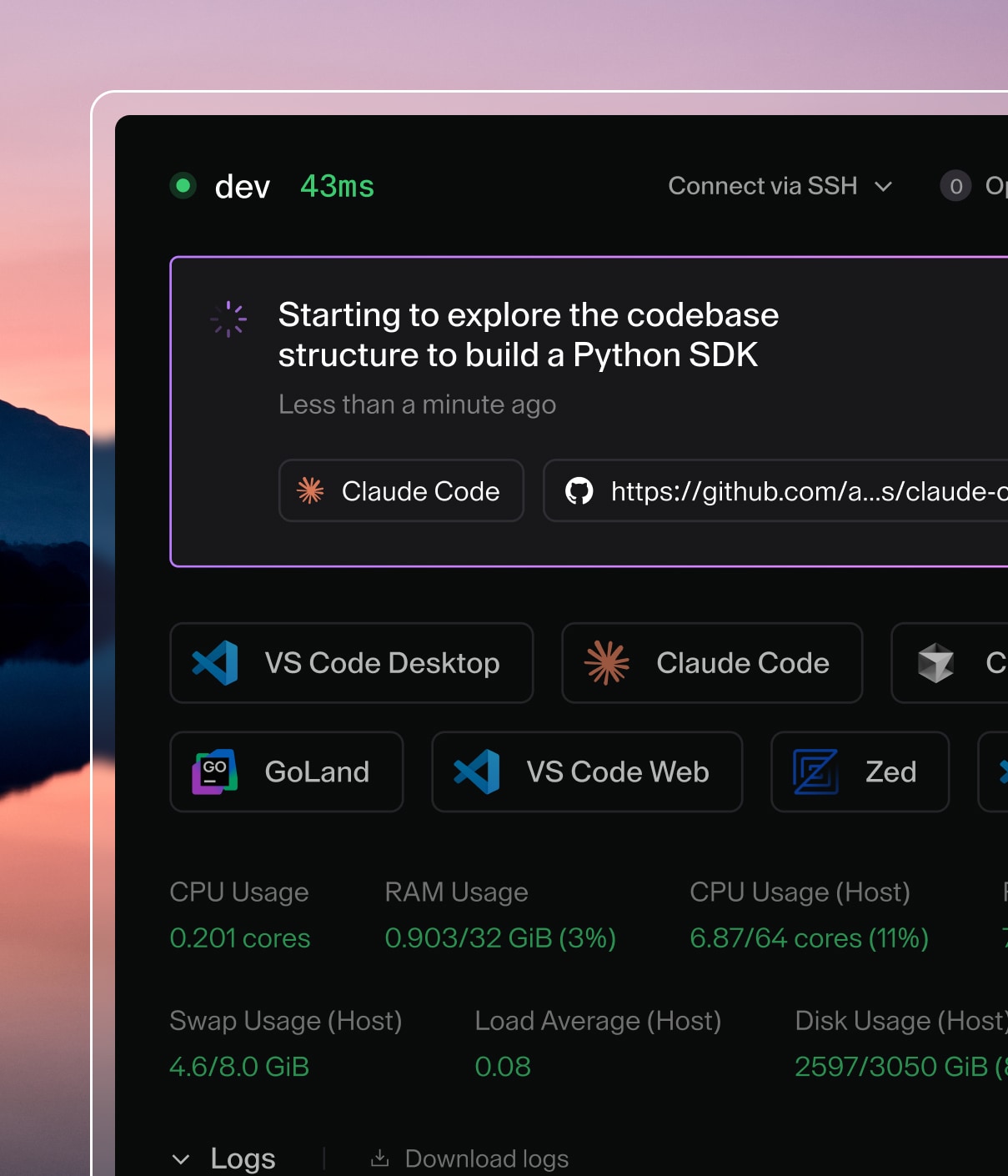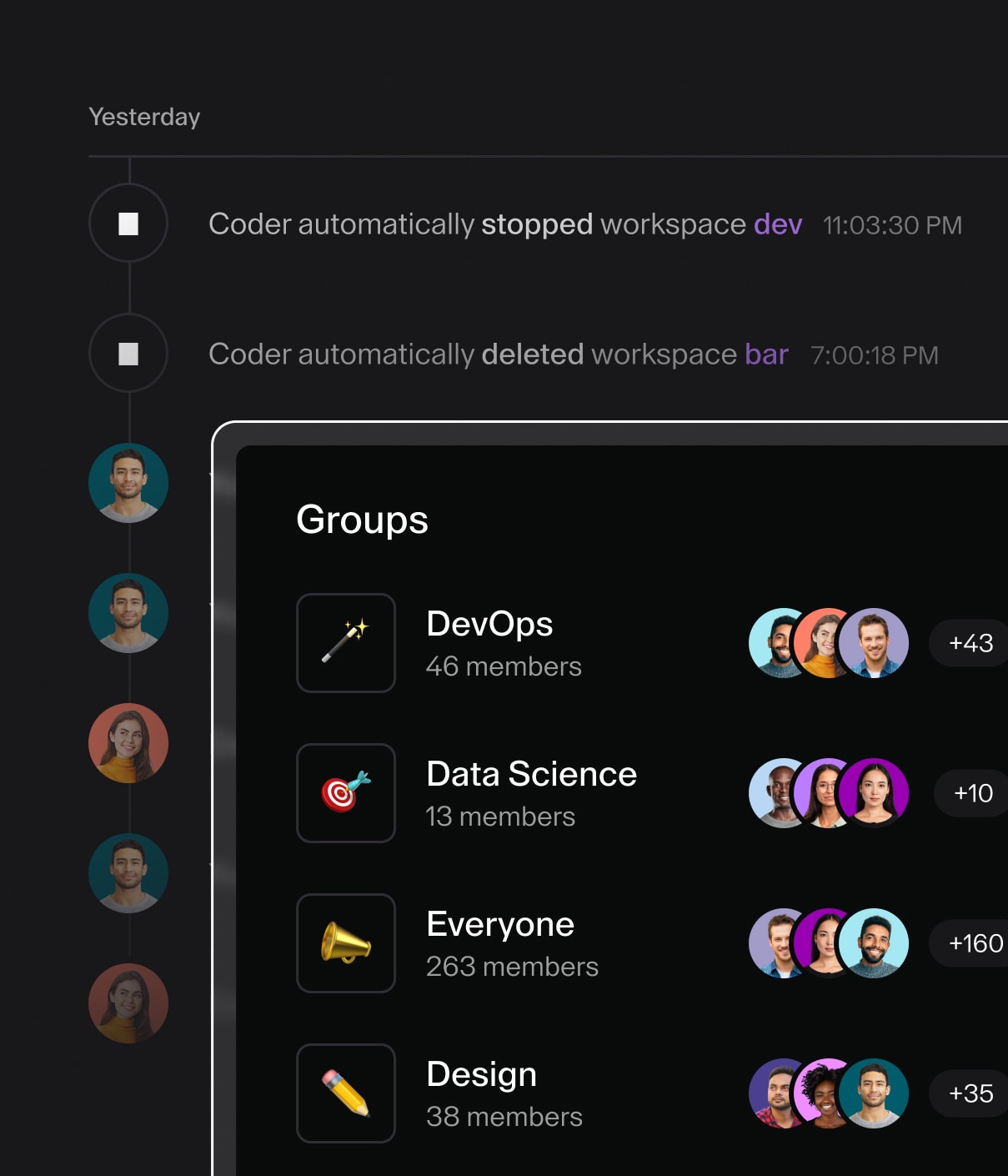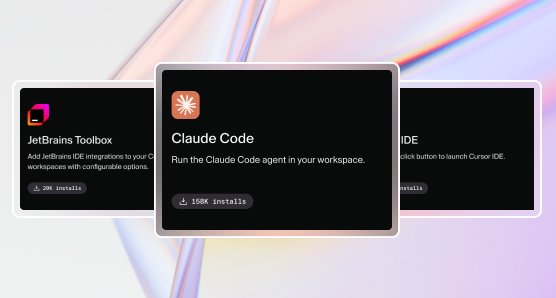Contributing
Requirements
We recommend using the Nix package manager as it makes any pain related to maintaining dependency versions just disappear. Once nix has been installed the development environment can be manually instantiated through the nix-shell command:
$ cd ~/code/coder
# https://nix.dev/tutorials/declarative-and-reproducible-developer-environments
$ nix-shell
...
copying path '/nix/store/3ms6cs5210n8vfb5a7jkdvzrzdagqzbp-iana-etc-20210225' from 'https://cache.nixos.org'...
copying path '/nix/store/dxg5aijpyy36clz05wjsyk90gqcdzbam-iana-etc-20220520' from 'https://cache.nixos.org'...
copying path '/nix/store/v2gvj8whv241nj4lzha3flq8pnllcmvv-ignore-5.2.0.tgz' from 'https://cache.nixos.org'...
...
If direnv is installed and the hooks are configured then the development environment can be automatically instantiated by creating the following .envrc, thus removing the need to run nix-shell by hand!
$ cd ~/code/coder
$ echo "use nix" >.envrc
$ direnv allow
Now, whenever you enter the project folder, direnv will prepare the environment for you:
$ cd ~/code/coder
# https://direnv.net/docs/hook.html
direnv: loading ~/code/coder/.envrc
direnv: using nix
direnv: export +AR +AS +CC +CONFIG_SHELL +CXX +HOST_PATH +IN_NIX_SHELL +LD +NIX_BINTOOLS +NIX_BINTOOLS_WRAPPER_TARGET_HOST_x86_64_unknown_linux_gnu +NIX_BUILD_CORES +NIX_BUILD_TOP +NIX_CC +NIX_CC_WRAPPER_TARGET_HOST_x86_64_unknown_linux_gnu +NIX_CFLAGS_COMPILE +NIX_ENFORCE_NO_NATIVE +NIX_HARDENING_ENABLE +NIX_INDENT_MAKE +NIX_LDFLAGS +NIX_STORE +NM +NODE_PATH +OBJCOPY +OBJDUMP +RANLIB +READELF +SIZE +SOURCE_DATE_EPOCH +STRINGS +STRIP +TEMP +TEMPDIR +TMP +TMPDIR +XDG_DATA_DIRS +buildInputs +buildPhase +builder +cmakeFlags +configureFlags +depsBuildBuild +depsBuildBuildPropagated +depsBuildTarget +depsBuildTargetPropagated +depsHostHost +depsHostHostPropagated +depsTargetTarget +depsTargetTargetPropagated +doCheck +doInstallCheck +mesonFlags +name +nativeBuildInputs +out +outputs +patches +phases +propagatedBuildInputs +propagatedNativeBuildInputs +shell +shellHook +stdenv +strictDeps +system ~PATH
🎉
Alternatively if you do not want to use nix then you'll need to install the need the following tools by hand:
- Go 1.18+
- on macOS, run
brew install go
- on macOS, run
- Node 14+
- on macOS, run
brew install node
- on macOS, run
- GNU Make 4.0+
- on macOS, run
brew install make
- on macOS, run
shfmt- on macOS, run
brew install shfmt
- on macOS, run
nfpm- on macOS, run
brew install goreleaser/tap/nfpm && brew install nfpm
- on macOS, run
pg_dump- on macOS, run
brew install libpq zstd - on Linux, install
zstd
- on macOS, run
pkg-config- on macOS, run
brew install pkg-config
- on macOS, run
pixman- on macOS, run
brew install pixman
- on macOS, run
cairo- on macOS, run
brew install cairo
- on macOS, run
pango- on macOS, run
brew install pango
- on macOS, run
pandoc- on macOS, run
brew install pandocomatic
- on macOS, run
Development workflow
Use the following make commands and scripts in development:
./scripts/develop.shruns the frontend and backend development servermake buildcompiles binaries and release packagesmake installinstalls binaries to$GOPATH/binmake test
Adding database migrations and fixtures
Database migrations
Database migrations are managed with migrate.
To add new migrations, use the following command:
$ ./coderd/database/migrations/create_fixture.sh my name
/home/coder/src/coder/coderd/database/migrations/000070_my_name.up.sql
/home/coder/src/coder/coderd/database/migrations/000070_my_name.down.sql
Run "make gen" to generate models.
Then write queries into the generated .up.sql and .down.sql files and commit
them into the repository. The down script should make a best-effort to retain as
much data as possible.
Database fixtures (for testing migrations)
There are two types of fixtures that are used to test that migrations don't break existing Coder deployments:
- Partial fixtures
migrations/testdata/fixtures - Full database dumps
migrations/testdata/full_dumps
Both types behave like database migrations (they also migrate). Their behavior mirrors Coder migrations such that when migration
number 000022 is applied, fixture 000022 is applied afterwards.
Partial fixtures are used to conveniently add data to newly created tables so that we can ensure that this data is migrated without issue.
Full database dumps are for testing the migration of fully-fledged Coder deployments. These are usually done for a specific version of Coder and are often fixed in time. A full database dump may be necessary when testing the migration of multiple features or complex configurations.
To add a new partial fixture, run the following command:
$ ./coderd/database/migrations/create_fixture.sh my fixture
/home/coder/src/coder/coderd/database/migrations/testdata/fixtures/000070_my_fixture.up.sql
Then add some queries to insert data and commit the file to the repo. See
000024_example.up.sql
for an example.
To create a full dump, run a fully fledged Coder deployment and use it to generate data in the database. Then shut down the deployment and take a snapshot of the database.
$ mkdir -p coderd/database/migrations/testdata/full_dumps/v0.12.2 && cd $_
$ pg_dump "postgres://coder@localhost:..." -a --inserts >000069_dump_v0.12.2.up.sql
Make sure sensitive data in the dump is desensitized, for instance names, emails, OAuth tokens and other secrets. Then commit the dump to the project.
To find out what the latest migration for a version of Coder is, use the following command:
$ git ls-files v0.12.2 -- coderd/database/migrations/*.up.sql
This helps in naming the dump (e.g. 000069 above).
Styling
Documentation
Our style guide for authoring documentation can be found here.
Backend
Use Go style
Contributions must adhere to the guidelines outlined in Effective
Go. We prefer linting rules over documenting
styles (run ours with make lint); humans are error-prone!
Read Go's Code Review Comments Wiki for information on common comments made during reviews of Go code.
Avoid unused packages
Coder writes packages that are used during implementation. It isn't easy to validate whether an abstraction is valid until it's checked against an implementation. This results in a larger changeset, but it provides reviewers with a holistic perspective regarding the contribution.
Frontend
Follow component conventions
Each component gets its own folder. Make sure you add a test and Storybook stories for the component as well. By keeping these tidy, the codebase will remain easy-to-navigate, healthy and maintainable for all contributors.
Keep accessibility in mind
We strive to keep our UI accessible. When using colors, avoid adding new elements with low color contrast. Always use labels on inputs, not just placeholders. These are important for screen-readers.
Reviews
The following information has been borrowed from Go's review philosophy.
Coder values thorough reviews. For each review comment that you receive, please "close" it by implementing the suggestion or providing an explanation on why the suggestion isn't the best option. Be sure to do this for each comment; you can click Done to indicate that you've implemented the suggestion, or you can add a comment explaining why you aren't implementing the suggestion (or what you chose to implement instead).
It is perfectly normal for changes to go through several rounds of reviews, with one or more reviewers making new comments every time, then waiting for an updated change before reviewing again. All contributors, including those from maintainers, are subject to the same review cycle; this process is not meant to be applied selectively or to discourage anyone from contributing.
Releases
Coder releases are initiated via ./scripts/release.sh and automated via GitHub Actions. Specifically, the release.yaml workflow. They are created based on the current main branch.
The release notes for a release are automatically generated from commit titles and metadata from PRs that are merged into main.
Creating a release
The creation of a release is initiated via ./scripts/release.sh. This script will show a preview of the release that will be created, and if you choose to continue, create and push the tag which will trigger the creation of the release via GitHub Actions.
See ./scripts/release.sh --help for more information.
Creating a release (via workflow dispatch)
Typically the workflow dispatch is only used to test (dry-run) a release, meaning no actual release will take place. The workflow can be dispatched manually from Actions: Release. Simply press "Run workflow" and choose dry-run.
If a release has failed after the tag has been created and pushed, it can be retried by again, pressing "Run workflow", changing "Use workflow from" from "Branch: main" to "Tag: vX.X.X" and not selecting dry-run.
Commit messages
Commit messages should follow the Conventional Commits 1.0.0 specification.
Allowed commit types (feat, fix, etc.) are listed in conventional-commit-types. Note that these types are also used to automatically sort and organize the release notes.
A good commit message title uses the imperative, present tense and is ~50 characters long (no more than 72).
Examples:
- Good:
feat(api): Add feature X - Bad:
feat(api): Added feature X(past tense)
A good rule of thumb for writing good commit messages is to recite: If applied, this commit will ....
Note: We lint PR titles to ensure they follow the Conventional Commits specification, however, it's still possible to merge PRs on GitHub with a badly formatted title. Take care when merging single-commit PRs as GitHub may prefer to use the original commit title instead of the PR title.
Breaking changes
Breaking changes can be triggered in two ways:
- Add
!to the commit message title, e.g.feat(api)!: Remove deprecated endpoint /test - Add the
release/breakinglabel to a PR that has, or will be, merged intomain.
Security
The security label can be added to PRs that have, or will be, merged into main. Doing so will make sure the change stands out in the release notes.


